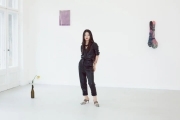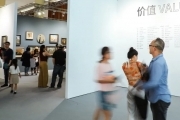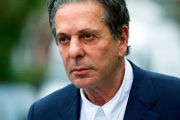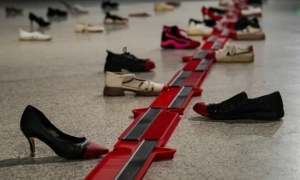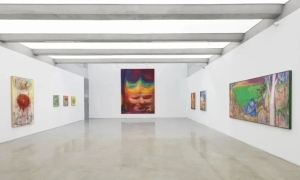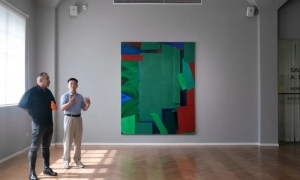1976 2008 布面丙烯 220x165cm
爬 2008 布面丙烯 165x220cm
公园里的雕像1 2008 布面丙烯 165x220cm
Boers Li 画廊将在十一月八日至十二月二十一日期间于主展厅展出龚剑个展——“人民公园”。在是次展出的绘画作品中, 龚剑摒弃了早期作品对高级/低级, 民间艺术/当代艺术的拼凑,转而从生活碎折的意难平中,锻造自己的艺术语言。
龚剑,1978年生,现居武汉, 作品媒介多样化, 从绘画到装置作品兼具。龚剑活跃于艺术边缘,在作品风格和介入社会的方式上,他另辟蹊径,其别树一帜使他成为同辈艺术家中有趣的一员。
在他的早期作品中,龚剑改编了一些中国民间绘画,以戏谑的方式表达荒诞的政治与历史主题。油彩技巧和旧式社会主义的现实主义民间绘画塑建了龚剑的笔法,他把二者融合,技巧的娴熟确实为人所称道。龚剑大胆的用色使画面造成强烈的视觉刺激,把观者引往盘桓画布之上,讽刺时弊的弦外之音。
尽管龚剑并未完全扬弃他以往的市井式文化嘲戏,可是近来他确实收敛了他的戏谑态度,转而涉足一系列的学术实验,例如研究关于深度和真实性的话语,并探索风格和语境关系。
无论对象是公共领域还是美术史,介入是贯穿龚剑至今艺术生涯的概念 。龚剑的油画新作捕捉了他早期作品的艳丽与视觉趣味,同时保留了近期作品以概念主导之学术优势。
龚剑自接触绘画开始,便被这一平面媒介所包含的可能性所吸引,这促使他对绘画风格和主题进行了广泛而持续的探索。在艺术家的早期创作中,他以亦庄亦谐的手法,为自己开拓了多样化的艺术方向。在《人民公园》中,作品的重点从说教和后现代主义移开,取而代之的,是艺术家对风格的意义的诘问。
人民公园是环绕这次展出作品的主题(同名的城市空间有如复制一般,出现在中国各大城市)。人民公园是一个从不真正开放予意义上的公众的公共空间,这些公园是欲望和秘密圈子的麋聚之地。同性恋人的邂逅,老者的太极,人群高唱的革命歌曲,集体歌舞……这些场景在人民公园屡见不鲜。人民公园作为公共空间,是私人欲望和公共领域的接触面,当中的社会与情感内涵是龚剑在这次展览探究的对象。
龚剑笔下的森林,草地,以至匍匐着的人体,全都显得张狂而情感充沛,它们拼缀成艺术家的文化宇宙。龚剑从日常语境里撕掳这些事物,并把它们加插在他倾斜的视觉世界里。这些枯燥的景物被抽调到画布上,化为静物,并获赋予一种来自动态缺席的运动。这种转化透过作品里的光影反差与戏用,为作品开拓了供他者观察的空间。
龚剑作品的构图笔触皆为简洁,其中蛰伏着艺术家残酷而伤感的凝视,艺术家的凝视表达了人类和文明带来的暴力。龚剑作品中的模糊混沌展现出一种如梦似幻的特质, 稚嫩的乌托邦梦幻和混乱、险恶共冶一炉。主题和背景在龚剑的作品里边界模糊,这是其作品里暴力的极至。在此,观者被施与艺术家的凝视带来的暴力,观者只能任由视觉迷滞在画布上的混沌里。
AV 大久保将于开幕式演出,这支武汉摇滚乐队曾触动不少国内乐迷,且他们鲜有在北京演出,切勿错过。
Dates:8 November – 21 December
Time:Tuesday – Sunday 11:00 – 18:00
Opening:8 November, 16:00-18:00
Place:Boers-Li Gallery, Caochangdi No. A-8
Boers-Li Gallery is pleased to announce that Gong Jian will be featured in the next solo exhibition in the main space, Gallery I. Entitled People’s Park, the exhibition will open to the public on 8 November and run through 21 December. These paintings leave behind the pastiche of high/low and folk/contemporary that characterized much of the artist’s early work, instead forging an artistic language steeped in the fragmentsof a half-lived life.
Gong Jian, a young artist born in 1978 and based in Wuhan, works in a diverse range of media from painting to installation. Notable for his successful willingness to work and from the periphery of the Chinese art world, he has consistently proven himself to be one of the most interesting artists of his generations by attempting to forge his own path in terms of stylistic development and social intervention.
In his earlier work, he playfully adapted the vernacular of Chinese folk painting to approach absurdist political and historical themes. Particularly well-developed is his blending of oil materials with the older graphic styles of pre-socialist realism folk painting. His brushwork reflects this variety of influences, while his use of color creates striking visual compositions that draw attention to this subtle and ironic social commentary.
Recently, he has moved towards less playful and more academically informed experiments with discourses of depth and authenticity, examining the relationship between style and content—although this is not to say that he has abandoned the crass pop culture jokes. Throughout his career, the artist has concentrated on the concept of the intervention, in both public space and art history. His newest oil paintings capture the vibrancy and visual interest of his colorful earlier works while maintaining the academic edge of his conceptually rich recent work.
Interested primarily in the possibilities of painting itself, Gong Jian has explored a vast range of both styles and subjects. None of these thematic threads ever disappear from his practice, but the artist has certainly approached specific creative directions with varying degrees of rigor and interest over the span of his early career. Here, the audience finds a reduction of the didactic and thematically postmodern; instead, they are replaced with an interrogation of the meaning of style itself.
The paintings in this exhibition revolve around the concept of the People’s Park (an urban space found in identically-named iterations in most cities across China). Representing a public space that can never be truly available to any meaningful public, such parks have become repositories for private scenes and desires: trysting students, homosexual encounters, geriatric tai-chi, revolutionary sing-alongs, and group dances are all common scenes. This space, an interface between private desires and public lives, carries a set of social and emotional connotations explored by the artist in this exhibition.
The subjects of these paintings include aggressive but empathetic takes on forests, grass, and erotic crawling figures—all pieces of Gong Jian’s cultural universe that he rips from their standard contexts and inserts into his new world of skewed visuality. These prosaic scenes are abstracted onto his canvases, transformed into static objects, and endowed with a sense of motion that comes from without. This transformation creates a space for observation via a repetitious composition that plays on light and a strong sense of contrast.
The gaze of the artist, recalling the violence of human or social presence through both visual framing and the terse brushstrokes themselves, is both harsh and melancholy. In some ways, however, this indiscernible and undifferentiated mass of the observed takes on a certain dreamlike quality, melding the oneiric and utopian infantile phantasy with the sinister and chaotic. Gong Jian’s ultimate act of artistic violence is the blurring of the subject and its background, making it difficult for the viewer to concentrate or see any clear object—the viewer, too, is subjected to the violence of this painterly gaze.
The opening reception will include a performance by Wuhan-based rock band AV Okubo, whose sets have electrified audiences across China. This show will be a not-to-miss rare visit to Beijing.
For more information on the coming exhibition, please feel free to contact us.
【编辑:霍春常】




